Abstract
Oil and gas occur in basement reservoirs in many parts of the world. The reserves range from as small as one or two million barrels of oil or gas equivalent to as much as almost two billion barrels of oil, as in Libya’s Augila-Naafora field. Exploration has been remarkably successful in the past decade, with important discoveries in China, Indonesia, the United Kingdom, Norway, Chad, and Argentina. In order to successfully develop these fields, and also to avoid costly mistakes, all available geological, geophysical, reservoir engineering and economic data must be closely studied. Also, it is very important to study analogues of basement oil and gas fields worldwide, in order to understand why some fields are very successful and others turn out to be failures.
Introduction
Basement rocks are important oil and gas producing reservoirs in a number of basins worldwide, including Asia (China, Vietnam, Indonesia, and Malaysia), India, Russia, Kazakhstan, Yemen, Africa (Algeria, Libya, Egypt, South Sudan and Angola), South America (Venezuela, Brazil and Argentina), the USA (California, Kansas, Oklahoma and Texas), and the North Sea (UK and Norway) (see map, Fig. 1). The basement reservoirs include fractured and weathered granites, quartzites, carbonates, metamorphics and volcanics.
The basement oil and gas play has intensified in the past decade, with significant recent discoveries in China and Chad, and a major gas discovery, Kaliberau, in 2019, in Sumatra, Indonesia. Significant discoveries have also been made in the North Sea, in the Lancaster field in the West of Shetlands in the UK, and the offshore Rolvsnes oil discovery in Norway.
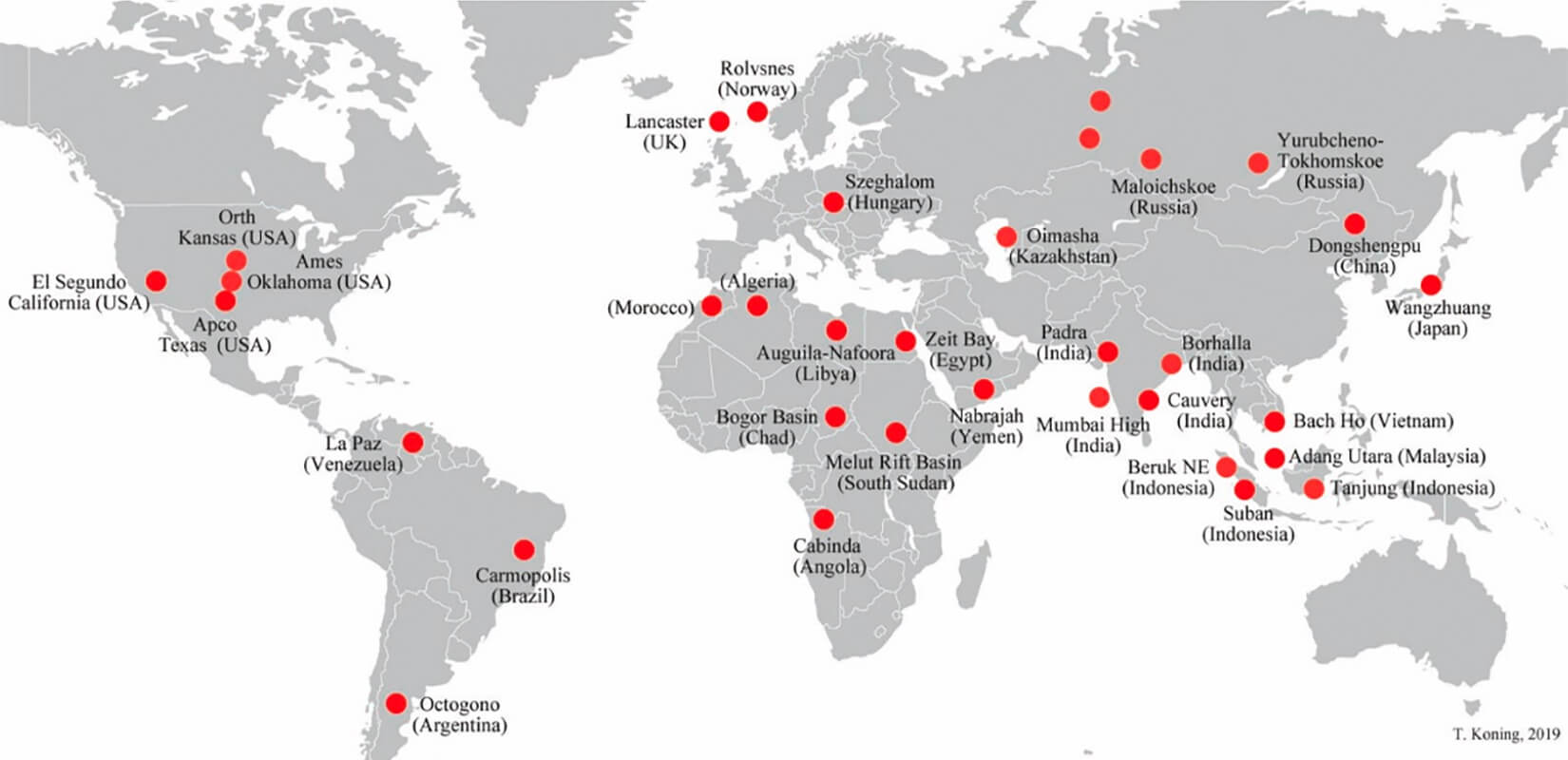
The author has followed this subject closely for 40 years, since being involved in 1982 with the development of the Beruk Northeast basement oil pool in Indonesia. He has also been involved with evaluating basement oil discoveries in Angola and Uganda. He hereby shares his knowledge and experience.
This paper provides a technical review of select fields in Asia, Africa and the Americas. Also reviewed are “best practices” for exploring and developing basement fields. Although this paper reviews mostly “success stories”, there are also failures, since basement reservoirs can be very complicated and unpredictable. Accordingly, two basement fields which proved to be economic failures, Dai Hung (Big Bear) in Vietnam and Beruk Northeast in Indonesia, are also reviewed. Reviewing such situations is important due to the saying, “We learn from our successes but we also learn from our failures”.
The biggest oil and gas basement fields occur within basement which is heavily naturally fractured. The opinion of this author is that the best rock types are fractured quartzites or granites, since they are brittle and thus fracture optimally (Koning, T.,2019). Weathered granitic basement can also be an excellent reservoir, as in the Augila-Naafora oil field in Libya, described later in this paper.
Fractured gneisses are poorer reservoirs, since they can be massive, dense, or slabby with open fractures parallel to the direction of foliation. Rocks such as gneisses and schists are ductile and tend to fold rather than fracture, when subjected to tectonic stress. Phyllites and slates are the least attractive, since such rocks are not brittle; rather, they are thinly bedded, fissile and ductile, and fracture poorly.
The following is the preference scale for basement reservoir rock types:
- Fractured quartzites Most preferred rock type
- Fractured granites
- Fractured carbonates
- Weathered granites
- Fractured gneisses
- Weathered gneisses
- Fractured schists
- Weathered schists
- Fractured slates and phyllites
- Weathered slates and phyllites Least preferred rock type
Oil and gas fields in basement require the same geological criteria as conventional oil and gas fields, which includes reservoir rocks (fractured or weathered basement), oil and gas source rocks adjacent to or overlying basement, structural closure, and cap rocks which seal off the basement reservoirs.
Noteworthy also with basement reservoirs is that with major to giant-size oil and gas fields, the oil or gas columns are typically very thick (see Table 1). For example, the oil column in the Bach Ho field in Vietnam has a thickness of 1,500 meters. Intense regional tectonics in areas such as in Vietnam, Indonesia and Chad has resulted in fractures extending as deep as 1,500 meters below the top of basement.
| Oil or Gas Field | Oil or Gas Column (m) | Oil-Water or Gas-Water Contact |
|---|---|---|
| Table 1. Oil and gas columns in major to giant-size oil and gas fields. From: Koning, T., 2020. | ||
| Bach Ho, Vietnam | 1500 m oil | No contact is identified |
| Chad, Central Africa | 1500 m oil | No published information |
| Suban, Indonesia | 1250 m gas | Gas-water contact is defined |
| Renqiu, China | 870 m oil | Oil-water contact is defined |
| Octongo, Argentina | 600 m oil & gas | Oil-water contact is defined |
| Bozhong 19-6, China | 600 m gas | Gas-water contact is defined |
| Dongshenpu, China | 400 m oil | Oil-water contact is defined |
| La Paz, Venezuela | 305 m oil | Oil-water contact is defined |
| Padra, India | 300 m oil | No published information |
| Padra, India | 260 m oil | No published information |
| Oymash, Kazakhstan | 190 m oil | Oil-water contact is defined |
The size of oil fields is classified by the American Association of Petroleum Geologists (AAPG) on the basis of major oil fields having reserves between 100 to 500 million barrels of oil, giant fields having reserves between 500 million barrels and 5 billion barrels of oil, and supergiant fields having reserves in excess of 5 billion barrels of oil. The same classification applies to gas fields, with the gas reserves converted to oil on a gas-to-oil equivalency basis.
In this paper, examples of major basement oil fields include Dongshenpu, China and the basement reservoir in the LaPaz field, Venezuela. Giant basement oil fields include Renqiu, China, Bach Ho, Vietnam and Augila-Naafora, Libya. There are no supergiant basement oil fields in the world. Kaliberau, Indonesia is a major gas field. Giant basement gas fields include Bozhong 19-6, China and Suban, Indonesia.
Asia’s basement oil and gas fields
China
1. Yaerxia oil field
The Yaerxia Field is an onshore oil field discovered in 1959, and is the first basement “buried hill” field ever discovered in China. The oil is produced from Paleozoic phyllites, slates, and meta-sandstones. The wells are moderately productive, with 12 wells producing less than 70 barrels of oil per day, 3 wells producing at 200 barrels of oil per day and 2 wells producing at 875 barrels of oil per day (Chung-Hsiang P’An,1982). The wells are not highly productive, since the phyllites and slates do not naturally fracture optimally. Similarly, phyllites and slates do not produce good reservoirs when they are weathered.
2. Renqiu oil field
Renqiu is a famous giant-size basement buried hill oil field discovered onshore China in 1975. The buried hill structure has a relief of 1,300 meters and an oil column of 870 meters (Chung-Hsiang P’an, 1982). Dolomitic carbonates of Cambrian and Ordovician age are the primary reservoirs in Renqiu. The average oil production per well in 1976 was 13,800 barrels per day. The estimated ultimate recovery was estimated by Horn, M. (1990) to be 2.3 billion barrels of oil and 0.7 trillion cubic feet of gas. Meyerhoff, A. and Willums, J., (1976) reported similar reserve estimates. Based on available published data, Renqiu is ranked as the world’s largest basement oil field.
3. Dongshenpu oil field
This field is located onshore central China, and, like the Yaerxia oil field, is an example of a Chinese buried hill basement oil field. The Dongshenpu oil field was discovered in 1983, and the reservoir consists of Precambrian granites, granulites, diabases, and hornblende gneisses. The rocks have no primary porosity, but porous reservoirs were developed by weathering and natural fracturing. The discovery well tested at 1,570 barrels of oil per day and subsequent development drilling has found the oil column to be 400 meters thick (Chung-Hsiang P’An, 1982). The reserves in this field were estimated at approximately 190 million barrels of oil.
4. Bozhong 19-6 gas field
The Bozhong 19-6 gas-condensate field was discovered just five years ago, in 2017, by the Chinese National Offshore Oil Company (CNOOC). Recently published data by Wang, L., 2021, indicates that the recoverable reserves in the basement amount to 3.3 trillion cubic feet of gas and 480 million barrels of condensate. However, other more recent publications, including Offshore Technology (2022), have indicated reserves of 6 trillion cubic feet of gas and 1.1 billion barrels of condensate. Upstream (2022) and China Daily News (2022) have reported similar estimated reserves. Accordingly, this recently discovered field is one of the world’s largest basement gas fields.
Vietnam
The largest oil field in Vietnam is the giant Bach Ho (White Tiger) basement oil field in the Cuu Long Basin. Other basement oil fields in the Cuu Long basin (Fig. 2) include the Dai Huang (Big Bear), Ca Ngu Vang (CNV), Rong (Dragon), Rang Dong, Ruby and Su Ten Den fields, with reserves ranging from 100 to 400 million barrels of oil (Koning,T., 2019; Chung-Hsiang P’An,1982; Hung, N. and Le, H., 2004).
1. Bach Ho (White Tiger) oil field
This is a giant oil field with estimated reserves of 1.0 to 1.4 billion barrels recoverable (Hung, N. and Le, H., 2004). The field was discovered in Vietnam’s Cuu Long Basin by Mobil in 1975, with oil found in Oligocene sediments draping a major basement structural high. Due to the political situation, Mobil, an American oil company, was not able to develop the field, and exited from Vietnam. However, in 1988, VietSovPetro discovered oil in fractured and weathered Precambrian granite basement. Oil production peaked at about 280,000 barrels of oil per day in 2005. The oil production is 95% from the basement reservoirs and 5% from the Oligocene sediments. Bach Ho’s production declined to 140,000 barrels of oil per day in 2009 and has continued to decline to 65,000 barrels of oil per day as of 2018.
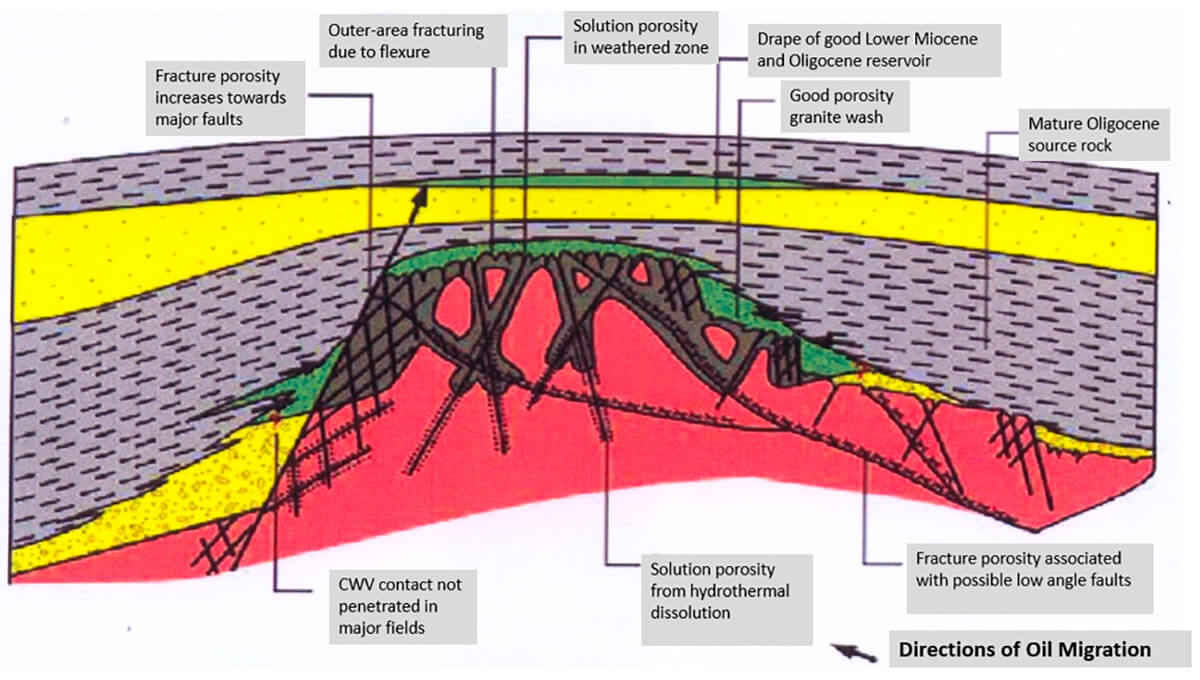
The oil is stored in macrofractures, microfractures, and vuggy porosity within the fractures. Matrix porosity within the unfractured granite is negligible. Most of the fractures inside the basement are at high dip angles of 40 – 75 degrees. Porosity in the fractures is only 2 – 3% but permeabilities are excellent at tens to thousands of millidarcies. Flow rates have been measured at up to 14,000 barrels of oil per day, per well. Bach Ho’s giant reserves are due to the oil column having a very large thickness of 1,500 meters.
2. Dai Hung (Big Bear) oil field
A contrast to the success of Bach Ho is provided by the development and production history of the Dai Hung field, where oil and gas is hosted in a similar granite - granodiorite matrix. In 1993, Australia’s BHP led a consortium that won the bid to develop this field, and predicted the field would produce 250,000 barrels of oil per day. A full-scale production platform was installed. However, the field began rapidly watering out after oil production commenced. Very disappointingly, by the mid-1990s the field was producing only 25,000 barrels of oil per day and output declined rapidly. In 1997, BHP left the consortium, announcing the field was not profitable.
The Malaysian state oil company, Petronas, took over as operator but failed to raise the output beyond 10,000 – 15,000 barrels of oil per day, and left in 1999. In 2000, VietSovPetro, the Vietnamese and Russian joint venture operator of the Bach Ho and Rong fields, became operator of Dai Hung, but was only able to produce about 5,400 barrels of oil per day. The “lessons learned” from Dai Hung were that it is very important to fully understand the geological, geophysical and reservoir complexities of such a field prior to embarking on full-scale production, and especially important is the need to carry out long-term production testing in order to determine a field’s commerciality.
3. Ca Ngu Vang (CNV) oil field
The CNV field was discovered in 2002 and is the deepest oil-bearing structure in the Cuu Long Basin (Fig. 2), with the top of basement at a depth of 3,700 meters. CNV is a buried hill field, as is the Bach Ho field, and produces from fractured Precambrian granites. The operator of the field was United Kingdom-based SOCO International, who are now Pharos Energy. The CNV-3 well was the longest measured well in Vietnam, at 6,123 meters, with over 2,000 meters of basement penetrated in a near-horizontal drain hole (Fig. 3). The well tested both oil and gas at a rate of 13,040 barrels per day of oil and gas equivalent.
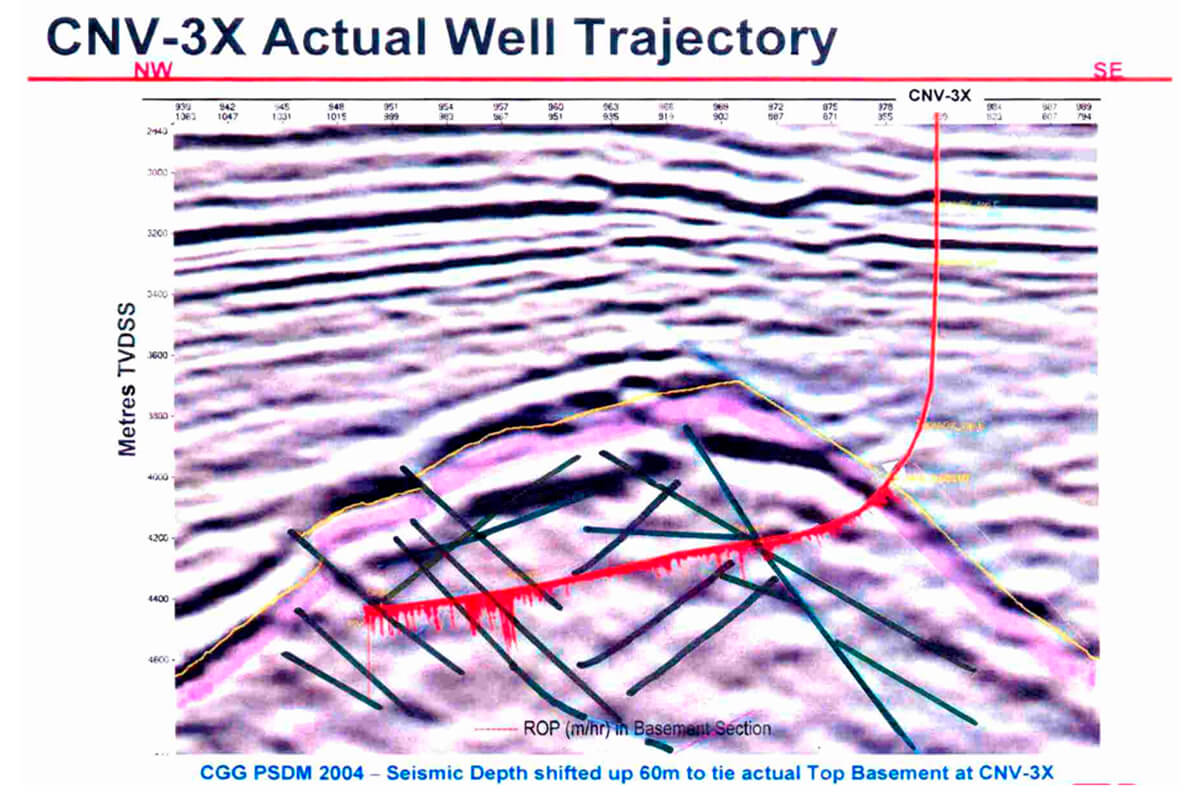
Indonesia
1. Suban gas field, South Sumatra
The Suban gas field (Fig. 4) was discovered by Gulf Canada Resources in 1999 by drilling deep into basement. Approximately 5 – 7 trillion cubic feet of gas was discovered in fractured pre-Tertiary age granites. Development wells were drilled at highly deviated angles and oriented perpendicular to the dominant fracture system. Results were that some wells had an absolute open flow (AOF) rate of gas at 1 billion cubic feet per day and deliverability of 150 million cubic feet of gas per day. Leading edge 3D seismic data has proven to be critical to the optimum development of Suban. The success of Suban has led to further successful exploration for gas in basement in South Sumatra, due to the need for more gas as the Indonesian economy continues to expand. Gas from the Suban field is pipelined to the huge Caltex Duri heavy oil steam flood project in Central Sumatra, as well as to Singapore and Jakarta for electricity generation. ConocoPhillips was the operator of the field but recently sold its interests in Indonesia to Medco Energy.
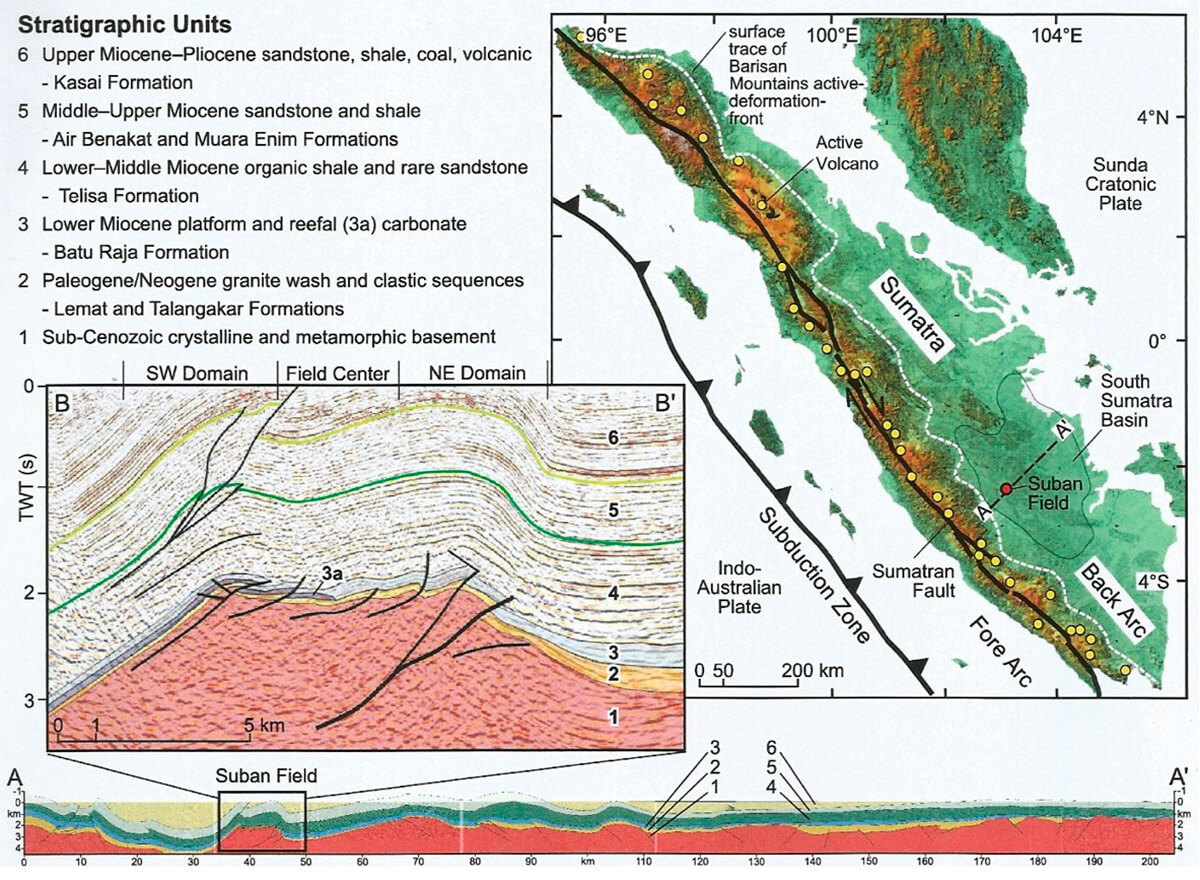
2. Kaliberau gas discovery, South Sumatra
In 2019, Repsol announced that their Kaliberau Dalam-2 exploration well had made a major gas discovery in fractured pre-Tertiary basement rocks. This discovery extended the basement gas play 50 kilometers to the northeast of the Suban field, mentioned above. The well was reported to have flowed at a rate of 45 million cubic feet of gas per day. Repsol mentioned that the discovery found at least 2 trillion cubic of gas. On a gas-to-oil equivalency basis, this equals 330 million barrels of oil. For Indonesia, the Kaliberau discovery is very significant, since it is its largest oil or gas discovery in the past 21 years, since the Cepu discovery in 2001.
3. Beruk Northeast oil pool, Central Sumatra
This basement pool appeared to be very promising, based on the flow rate of 1,680 barrels of oil per day from the discovery well, Beruk Northeast-1, drilled in 1976 (Koning, T. and Darmono, F., 1984). The oil-bearing reservoir drilled by the discovery well was a fractured quartzite, and radiometric age dating established a Permian age for the quartzite (Figs. 5 and 6). The discovery was followed up by four development wells, none of which were drilled deep into basement. Consequently, the operator Caltex (Chevron-Texaco) did not know about the presence of multiple underlying oil-water contacts. The field produced only 2 million barrels of oil when rapid water influx terminated the life of the field and rendered it noncommercial. The “lesson learned” was that wells need to be drilled sufficiently deep into the basement rather than simply touching or “tagging” into the top.
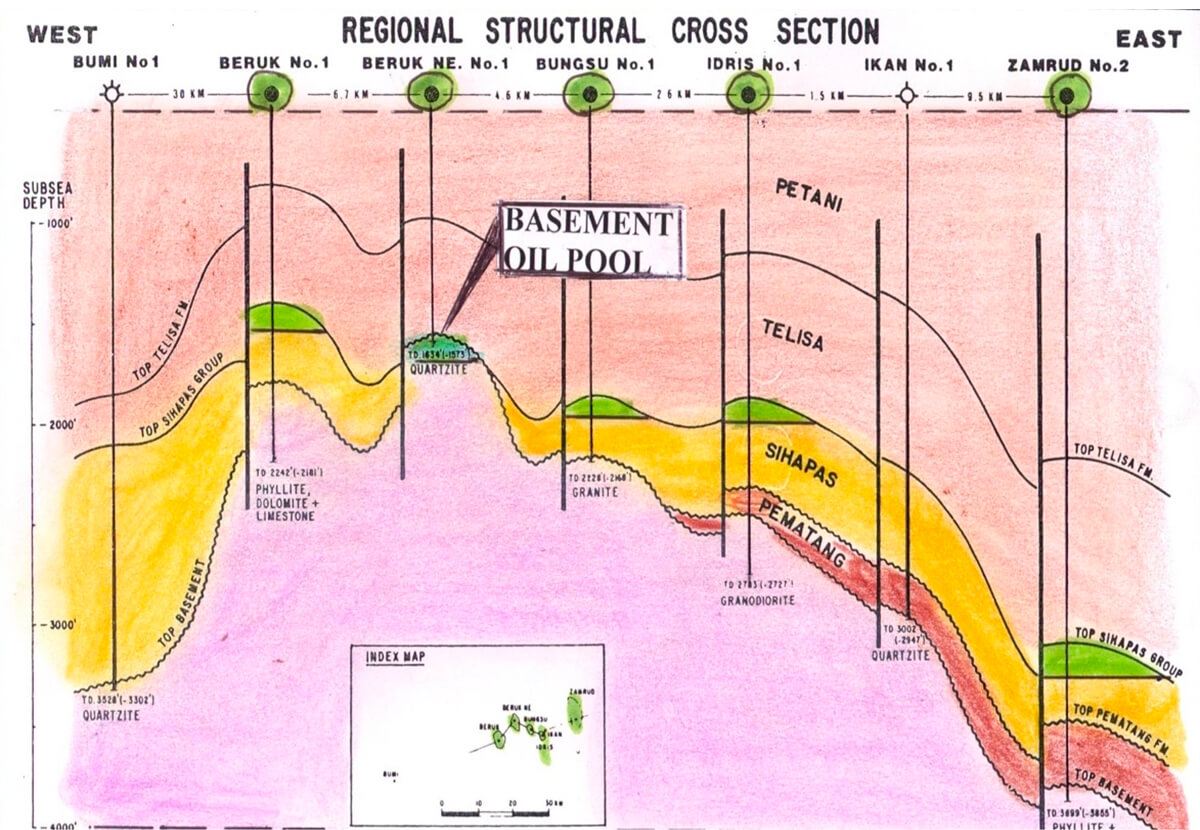
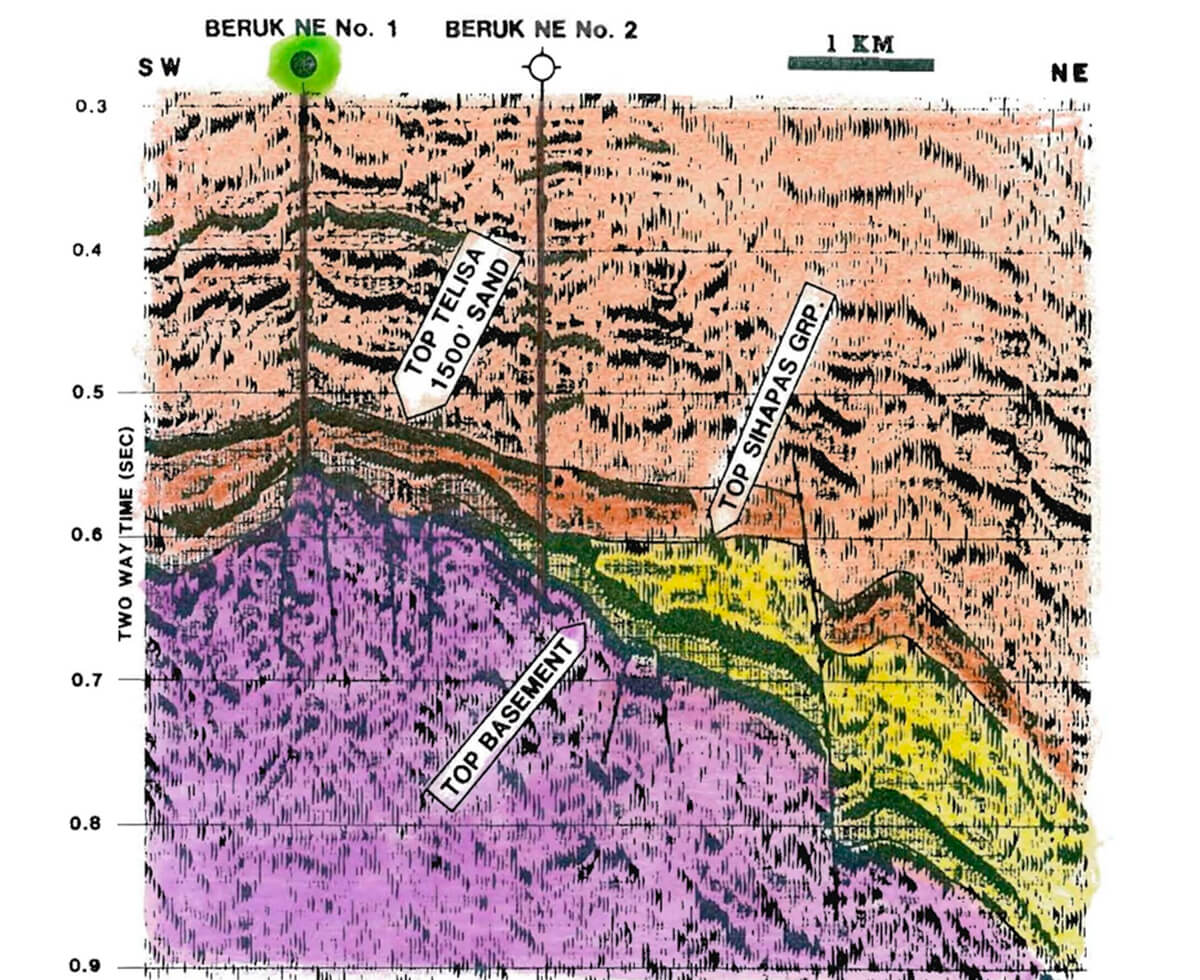
4. Tanjung oil field, Kalimantan
The largest oil accumulation in basement in Indonesia is the Tanjung field in the Barito Basin, southern Kalimantan. This field has produced over 70 million barrels of oil from Eocene sandstones and conglomerates overlying a faulted basement high, and it has also produced over 20 million barrels of oil from basement rocks including volcanics, pyroclastics and metasediments (Tiwar, S. and Taruno, J.,1979).
Malaysia
Adang Utara oil field
Malaysia’s first basement oil discovery occurred in 2005, with the drilling by Petronas of Adang Utara-1 in the offshore southern Malay Basin. The well was drilled to a total depth of 2,610 meters, including 120 vertical meters of basement penetrated. The flow rate of the discovery well is not available, however, six appraisal and development wells have been drilled. Flow rates from basement were as low as 159 barrels of oil per day to as high as 2,116 barrels of oil per day (Mandon, M., et al., 2015). The flow rates are much dependent on the wells optimally intersecting the oil-bearing basement fractures. No reserves information has been published on Adang Utara.
India
India is the third largest consumer of crude oil in the world, after the USA and China. India’s oil and gas demand has significantly outpaced its domestic production. In India, basement exploration is not a new concept, with established oil production from fractured and weathered basement in the Assam and Assam Arakan Basin, as well as in the Mumbai, Krishna Godaveri, Cauvery, and Cambay Basins. With the gradual decrease in large, easy-to-find oil pools, there has been a shift in the focus of exploration from conventional sedimentary reservoirs to exploration in basement.
1. Mumbai High oil field
An example of an Indian basement field is the Mumbai High field, which is located offshore from India’s west coast. This field was discovered in 1976 and produces from both basal sands and fractured Precambrian granites. Wells in basement have produced at rates of 465 to 2,575 barrels of oil per day (Satyanaryana, P. et al., 2010).
2. Padra oil field
Padra is another example of an Indian basement field. This onshore field produces oil from Deccan Traps volcanic basement consisting of layered basalts laid down by episodic lava flows which occurred in the Upper Cretaceous – Paleocene time period. The fractured and weathered basalts contain oil columns of up to 300 meters in thickness. The Borhalla oil field in northeastern India in the Assa Arakan basin also produces from fractured basement.
Africa’s basement oil and gas fields
Libya
Augila-Naafora oil field
Major to giant-size reserves of oil occur in basement in Libya. The Augila-Naafora field (Fig. 7) is a giant accumulation discovered in the mid-1960s in the Sirte Basin. The reservoir consists of hydrothermally altered, fractured and weathered Precambrian granite. The field is a prominent horst block created at the onset of rifting in Middle to Upper Cretaceous time (Harding, T.P., 1984). The discovery well, which found oil in basement, was tested at 7,627 barrels of oil per day. Thick, excellent oil source rocks onlap the basement high, and also act as the ultimate seal to the accumulation. The source rocks are Cretaceous basinal marine dark shales.
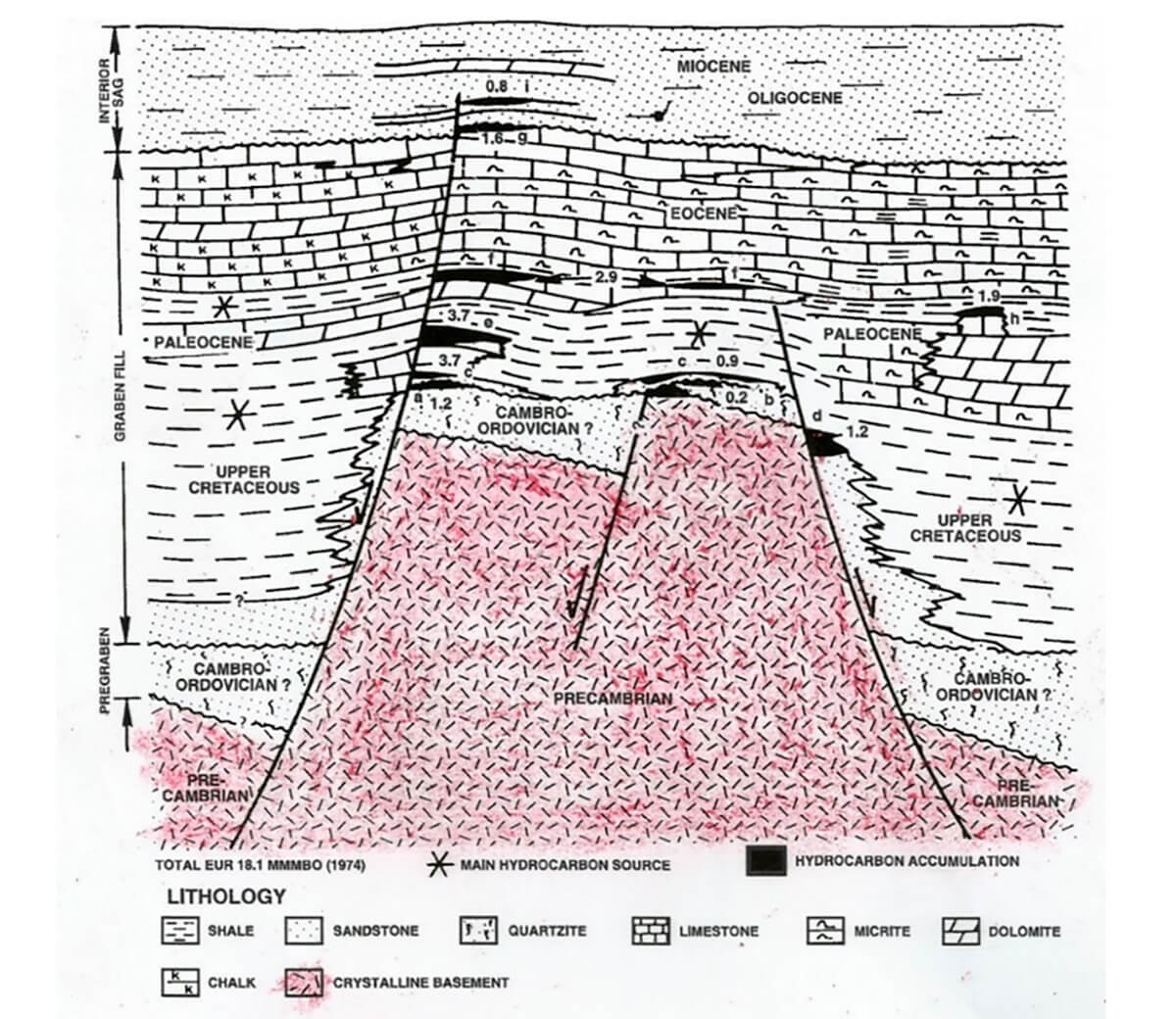
Primary porosity in the granite is low (2 – 3%) but hydrothermal alteration and weathering have led to about 6% average porosity in the weathered zone, and a maximum of about 11%. The weathering at the top of basement varies from as little as 5 meters to as much as 200 meters. There are sufficient open fractures in the basement structure to ensure effective fluids communication throughout the accumulation, and to guarantee good production rates.
Reserves are estimated at 9 billion barrels of oil in place, of which 90% occurs within basement and 10% in the overlying sediments. Production by 1984 was 820 million barrels of oil. The field is estimated to have ultimate production of 2 billion barrels, which is equivalent to a 22% recovery factor. Basement’s share of the production is estimated to be 1.8 billion barrels of oil. Accordingly, in the view of this author, Augila-Naafora is one of the largest basement oil fields in the world, and is a prime analogue for geoscientists who are searching for major oil or gas accumulations.
Egypt
Zeit Bay oil field
The Zeit Bay basement oil field is located in the offshore Gulf of Suez, and was discovered in 1981. The initial discovery well had an oil column of 260 meters. Approximately one third of the field’s reserves are in basement, with two thirds in the overlying sediments. Basement consists of granites, meta-volcanics, meta-sediments and dykes. Flow rates in basement vary from 700 to 9,000 barrels of oil per day (Zaharan, I. and Askry, S., 1988).
South Sudan
About 40 wells were drilled in the Melut Rift Basin, of which two wells flowed oil from basement at undisclosed flow rates. The reservoirs are granites and granitic gneisses. The Lower Cretaceous Renk formation is the major source rock in this basin (Bai, J. et al., 2016). There is little public domain information on South Sudan’s petroleum geology, but based on regional geology, one would expect that there is a high potential for oil and gas in the basement of South Sudan’s rift basins.
Chad
Lanea oil field
In 2013, the China National Petroleum Company (CNPC) made the Lanea-1 oil discovery in the Bogor Basin in granite basement in a buried hill structure with 1,000 meters of relief. This has been followed up by five more oil and gas discoveries in buried hills. The reservoirs are fractured granite and hydrothermally leached granite, the latter being the best reservoir facies. The source rocks and top seals are Early Cretaceous lacustrine shales. The oil column is 1,500 meters thick and the average well productivity is 1,500 barrels of oil per day (Bai, J. et al., 2016). The reserves have been estimated at approximately 100 million barrels, of which 70% is in basement and 30% in the overlying granite wash.
Angola
Cabinda onshore oil pools
In 1968, Gulf Oil Corporation drilled and completed Angola’s first basement oil discovery, well 61-1 in the onshore area of Angola’s province of Cabinda (Koning, T., 2014). The well flowed 600,000 barrels of oil on an extended flow test. Additional development drilling proved that 61-1 was a one-well pool. A second basement oil discovery was made by Gulf at 37-3, which tested up to 60 barrels of oil per day from basement. Neither of the Cabinda discoveries were commercial. However, no oil company has deliberately searched in Angola for oil in basement, and the basement oil play remains totally under-evaluated.

Figure 8 shows intensely fractured Precambrian granite in a fracture corridor in the interior of Angola. This potentially would be an excellent basement reservoir. Figure 9 shows a Precambrian granitic gneiss in the interior of Angola. This reservoir would be inferior, in comparison.
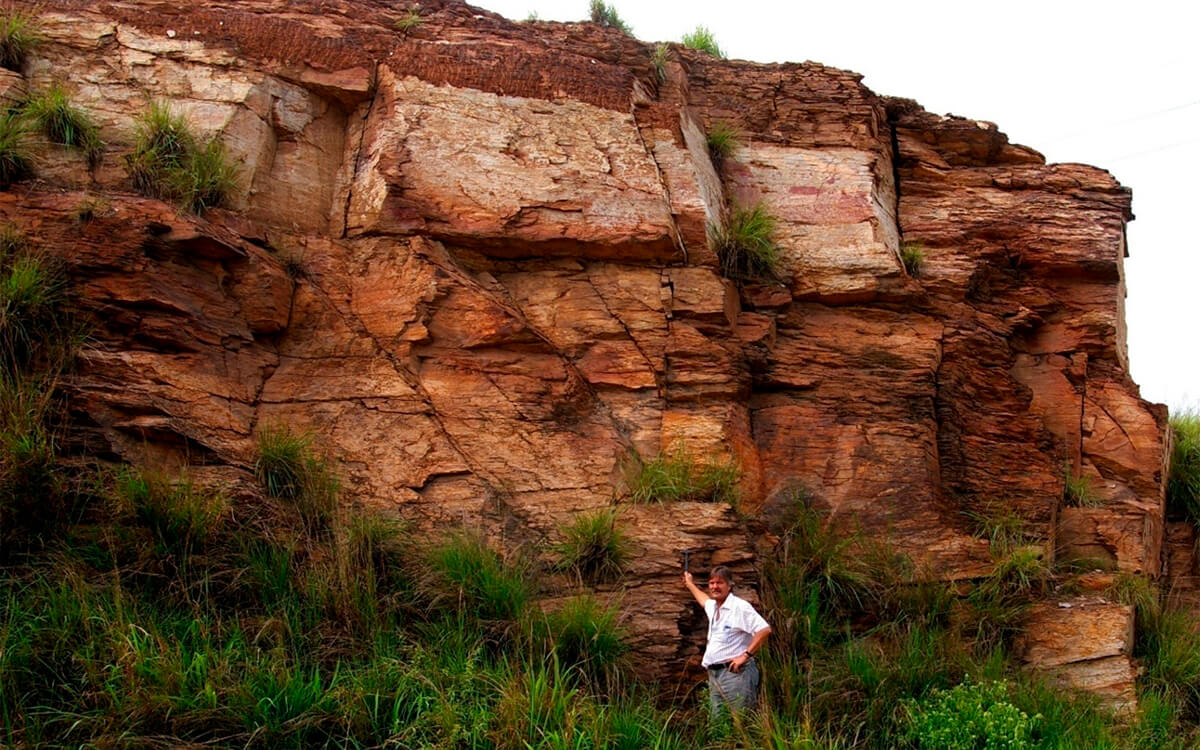
South America’s basement oil and gas fields
Venezuela
La Paz oil field
The La Paz oil field is located in the Maracaibo Basin in the interior of Venezuela. The field was discovered in 1944, and, up to 1992, produced 830 million barrels of oil from the La Luna limestones and 325 million barrels from the underlying fractured basement reservoir (Landes, K. et al., 1960; Talukdar, S. et al., 1994; Koning, T., 2003; Koning, T. 2018; see Fig. 10). After the discovery of the field, due to the strong production performance of the La Luna reservoir, the geoscientists and reservoir engineers speculated that the reservoir was obtaining production support from a deeper reservoir. Accordingly, 30 years after the discovery of the field, a well was drilled into the underlying basement and they discovered the La Paz basement field.
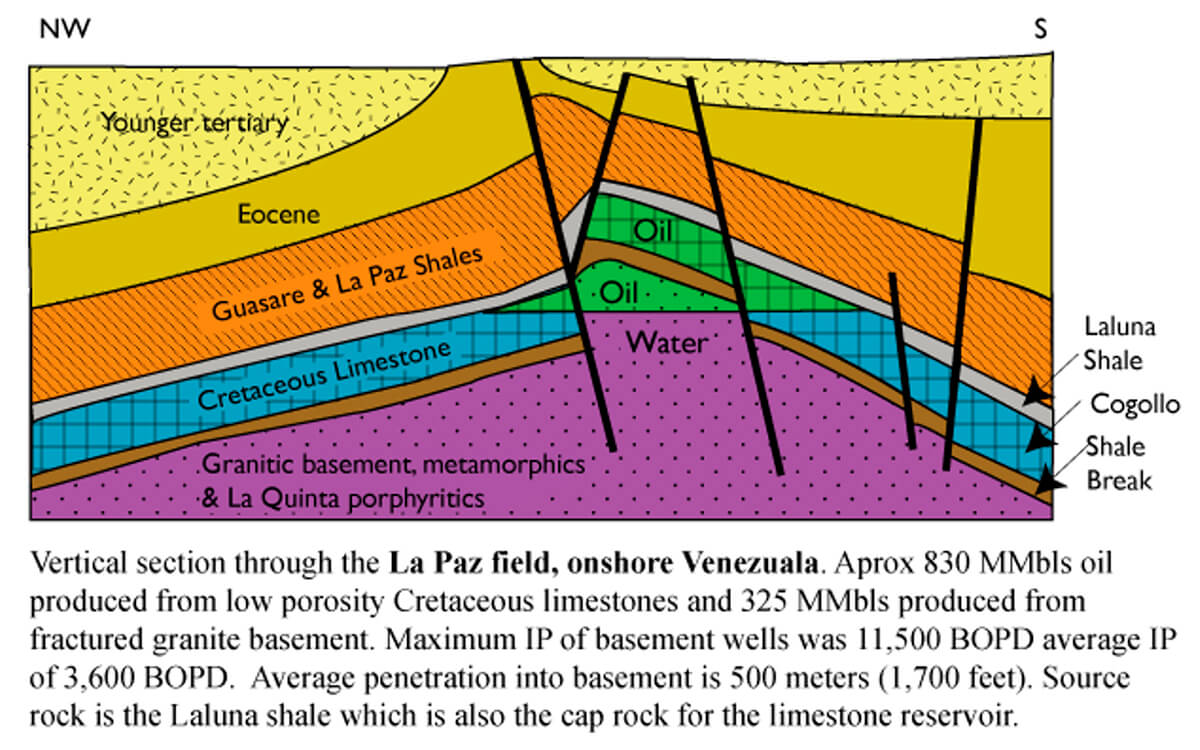
The discovery well produced at a rate of 1,000 barrels of oil per day from the La Luna limestone. Basement wells have had initial production rates of up to 11,500 barrels of oil per day, but the average initial production rate is 3,500 barrels of oil per day.
Brazil
Carmopolis oil field
The only field in Brazil which has produced oil or gas from basement is the Carmopolis field in the onshore Sergipe sub-basin. This field has produced oil from Cretaceous sandstones and the underlying basement. The depths of all reservoirs are very shallow, ranging from 400 to 800 meters. The oil gravity ranges from 24 to 30.5 degrees API. Approximately 85% of the oil production is from the overlying sediments and 15% from basement. Approximately 35 million barrels of oil has been produced from basement.
Argentina
Octogono oil field
The Octogono field is the only field in Argentina to have produced oil or gas from basement. This field was discovered in 1918 in the onshore Neuquen Basin and produced oil from the sediments overlying basement. Deeper drilling almost a century later focused on the basement, and resulted in oil discovered in basement which, in 2015, provided production of 3,000 barrels per day (Velo, 2014).
The primary source rock in the Neuquen basin is the organically-rich Vaca Muerta Formation (Spanish for Dead Cow) which is Late Jurassic to Early Cretaceous in age. In the Octogono field, the primary basement lithology is Paleozoic granite. All permeability and storage have resulted from fracturing and alteration. The uplift of basement by more than 1000 meters resulted in intense fracturing within the basement. Six alteration zones corresponding to differential weathering have been identified. The recovery factor in basement is estimated at 25% due to expansion of a 300-meter gas cap. The oil column in basement is also 300 meters. The discovery of oil in basement and the ongoing development of the basement reservoir has given new life to the Octogono Field.
North America’s basement oil and gas fields
USA
1. California
The state of California produces currently about 500,000 barrels of oil per day. This production is almost entirely from Tertiary Miocene age sandstones and conglomerates, except for the following fields which produce from basement reservoirs:
- Playa del Rey oil field, Santa Monica area. Production from fractured Jurassic schists.
- Santa Maria oil field, Santa Barbara area. Production from fractured Jurassic meta-sandstone basement.
- Wilmington oil field, Long Beach area. Production of 22 million barrels of oil from fractured Jurassic schists.
- Edison oil field, Bakersfield area. Production of 20 million barrels of oil from fractured Jurassic schists.
- El Segundo oil field, western Los Angeles area. Reservoir is fractured Jurassic schist in the west half of the field and fractured Jurassic schist conglomerate in the eastern half, with oil tested up to 4,500 barrels of oil per day from the basement, at a depth of about 2,150 meters (Landes, K. et al., 1960).
2. Kansas
Orth oil pool
Oil is produced in the state of Kansas from the top of fractured Precambrian quartzites which occur in buried hills. The oil source rocks are the overlying Pennsylvanian age shales, which also form the cap rock. Kansas has approximately 10 small pools which produced about 150,000 barrels of oil per well. An example is the Orth pool, which produced about 1 million barrels of oil from 15 wells (Landes, K. et al., 1960).
The production of oil from these small pools is commercially viable, since the shallow depths of the basement reservoirs result in modest drilling costs. The area where these basement pools occur is an area with extensive oil production from conventional oil fields and related existing oil production infrastructure, including pipelines and oil gathering stations. Accordingly, connecting the basement wells into the existing infrastructure is not expensive.
3. Oklahoma
Ames oil pool
The 15-kilometer diameter Ames structure in northwestern Oklahoma is a meteor impact structure created when a meteor struck in Middle Ordovician time. Oil and gas production is obtained from the brecciated Precambrian granite, as well as from the overlying Cambro-Ordovician Arbuckle dolomite.
4. Texas
Apco oil pool
Oil is produced from fractured Precambrian rocks in northern Texas, in the Panhandle-Hugoton area of the Anadarko Basin (Manwaring, M. and Weimer, B., 1986). These oil pools, including the Apco field, consist of basement highs which resulted from structural deformation and paleo-weathering. The oil is believed to have migrated from the Devonian-age Woodford shale into basement along ubiquitous fractures, and accumulated in open fracture zones associated with faults.
The depth of production averages 1,060 meters. Basement oil production ranges from as low as one barrel of oil per day to as high as 700 barrels of oil per day. Drilling within a fault zone does not assure basement production. Other geological factors are equally important to basement oil accumulations and production, including fault orientation, fracture type, mineralization within the fractures, degree of weathering, basement subcrop elevation, lithology, fault intensity, and proximity to fault-associated fracture zones. Proper drilling methods are equally important, as well as appropriate treatment of the basement reservoir during the completion of the well.
Canada
Canada is the world’s fourth largest oil producer, with production of 4.5 million barrels of oil per day. In view of Canada having such prolific petroleum geology, it is anomalous that there is no oil or gas production from basement anywhere in Canada. This may be attributable to the absence in Canada’s sedimentary basins of good oil or gas source rocks overlying basement which would feed oil or gas into basement. In addition, in Canada the basement oil and gas play is poorly understood by the geologists and geophysicists, thus there has never been a deliberate, highly-focused effort to explore for oil and gas in basement.
This author believes that the best place in Canada to explore for oil and gas in basement is in the Red Earth area of northern Alberta. In this area, much oil has been produced from very porous granite wash sandstones. However, no oil production has been reported from Precambrian basement horst blocks which occur at Red Earth. Perhaps no wells were drilled deep enough into basement to intersect existing oil columns. Also, perhaps the top of basement was not properly evaluated by electric logs, drillstem tests or production testing. Furthermore, weathering of granitic basement can produce reservoirs which, in core and cuttings samples, appear erroneously to be granite wash. Consequently, misinterpretation of the geology and seismic may have resulted in significant volumes of oil being undiscovered.
Accordingly, in my view, the Red Earth area warrants a comprehensive review of well logs, core data, test and production data and all available seismic control. This effort could lead to Canada finally becoming a producer of oil and gas from basement.
Best practices for exploring and producing oil and gas from basement reservoirs
- Exploration wells should be drilled highly deviated rather than vertical, in order to optimally intersect the dominant fracture system. Production wells should be drilled perpendicular or near-perpendicular to the dominant fracture system.
- Highly focused 3-dimensional (3D) seismic such as CGG’s CBM (Controlled Beam Migration) is needed to define the fracture systems in basement oil and gas fields. CGG’s CBM was used by SOCO in the development of the CNV field, Vietnam.
- Coring in fractured basement is difficult and not welcomed by the drilling engineers. Nonetheless, extensive core is needed to provide critically important information on the lithologies and reservoir parameters. Some of the cores should also be radiometrically age dated in order for the geologists to understand the complexities of the reservoir.
- Development wells should be drilled sufficiently deep to fully drain the reservoir. For example, in the La Paz basement oil field, Venezuela, wells are typically drilled 500 meters into basement. In China’s Dongshenpu buried hill basement field, the oil column is 400 meters thick and development wells typically are drilled through most of the reservoir.
- Exploration wells should not just “tag” the top of basement, since this will not allow for full evaluation of the basement and could result in an important discovery being “left behind”. Indeed, the Suban gas field, South Sumatra, was not discovered in the mid-1980s by Caltex (Chevron-Texaco) despite a major exploration program, since the wells were drilled through the sedimentary section and then merely tagged into basement. The underlying giant basement gas field with reserves of 5 - 7 trillion cubic feet of gas was subsequently discovered in 1999 by Gulf Canada and Canada’s Talisman Energy, by drilling deep into basement.
- There are a number of cases worldwide, such as the La Paz Field in Venezuela, where oil in the basement was discovered much later (30 years) in the life of the field, with the attention initially focused on producing oil from the overlying sedimentary reservoirs. A second example of this is the Octogono oil field, Neuquen Basin, Argentina, which was discovered in 1918 and produced oil from shallow sediments overlying basement. Finally, almost a century later, basement was drilled and evaluated, and now provides reserves and production upside. Production in 2015 from basement averaged 3,000 barrels of oil per day, and continues to increase, and has given a new life to this aging field. The La Paz and Octogono fields highlight that operators of oil and gas fields producing from sediments draped over basement highs should consider drilling a well down into the basement. High-resolution 3D seismic will help with defining the best location to optimally intersect the fractured or weathered basement.
- Weathered “rotten” granites can also be excellent reservoirs, as one can observe in outcrops in tropical areas, where heavy rainfall can leach out feldspars and less resistant minerals and leave behind an excellent reservoir. The high mafic minerals in schists, phyllites and slates prevent the creation of secondary porosity by weathering. In addition, granites and quartzites are more likely to produce attractive, highly porous “granite wash” sands, whereas eroded schists and gneisses do not produce such good quartz sand reservoirs.
- Geologists, geophysicists, reservoir engineers, and economists must study proven analogues of basement oil and gas fields worldwide, in order to fully understand any basement discoveries they are attempting to develop.
Conclusions
In the past, oil and gas fields in basement were discovered mostly by accident. The conventional thinking in the past was that basement was mostly tight and did not warrant exploring. However, in the past decade, significant oil and gas discoveries worldwide in basement provides encouragement for exploration programs deliberately targeting basement reservoirs.
Basement reservoirs are very unusual, in comparison to conventional sedimentary rock oil and gas reservoirs, since the basement reservoirs are in crystalline rocks. Accordingly, to successfully work with basement rocks, a special “mind set” is required which is open to all of the complexities associated with crystalline rocks. This author believes that significant oil and gas fields remain to be found in Asia, Africa, the Americas and worldwide. Unconventional geological and geophysical thinking and risk-taking has led to many of the world’s major oil and gas discoveries, and such strategies will reward the explorers searching for oil and gas in basement.
Understanding basement reservoirs is not only important for oil and gas, but this knowledge is also very relevant to the critical need to reduce the world’s Green House Gases (GHG). Carbon dioxide (CO2) can be captured and injected into fractured or weathered basement and thereby could be safely and permanently stored. Also, a commodity which is increasingly in short supply in the world is helium. In Saskatchewan and Alberta, significant programs have commenced exploring for helium. Economic helium is derived from the radioactive decay of uranium and thorium near basement rocks and granite washes. Accordingly, exploration for oil and gas in basement and exploration for helium could be carried out, hand-in-hand.
Lastly, the reader is referred to one of the first papers published on oil and gas in basement – the classic paper by K. K. Landes et al., in 1960, which states:
“Commercial oil deposits in basement rocks are not geological “accidents” but are oil accumulations which obey all of the rules of oil sourcing, migration and entrapment; therefore, in areas of not too deep basement, oil deposits within basement should be explored with the same professional skill and zeal as accumulations in the overlying sediments”.

Acknowledgements
Substantial parts of this paper were published previously in Georesources (a Russian publication):
Koning, T. (2019). Exploring in Asia, Africa and the Americas for oil & gas in naturally fractured basement reserovirs: best practices & lessons learned. Georesursy = Georesources, 21(4), pp.10-18. DOI: https://doi.org/10.18599/grs.2019.4.10-18
They are thanked for permission to re-publish in this Canadian forum. The author also wishes to express his appreciation to the Canadian Society of Exploration Geophysicists for publishing this paper.




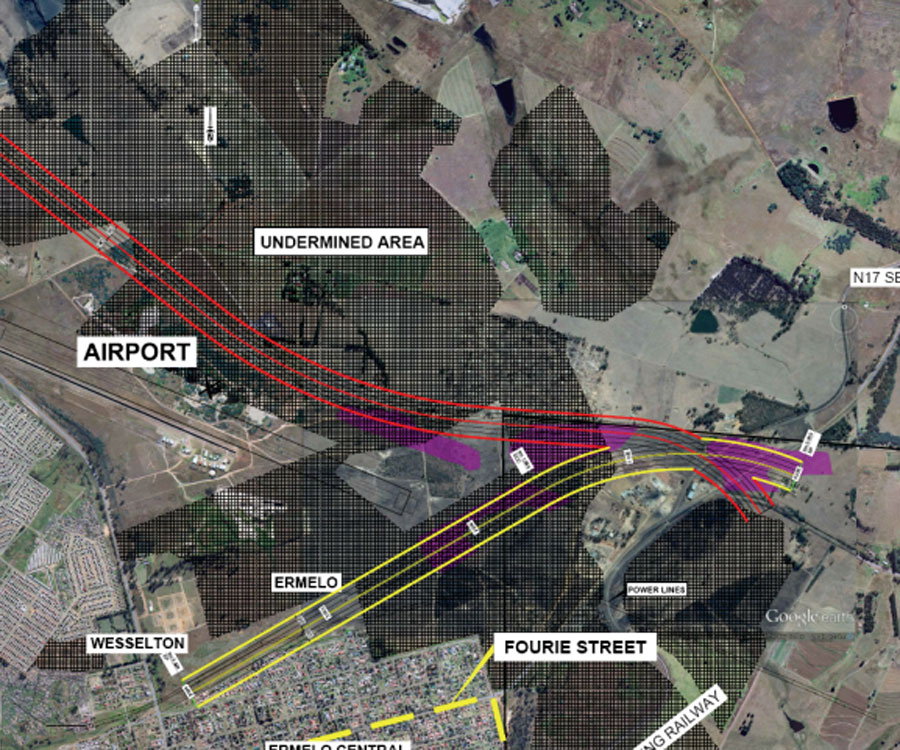
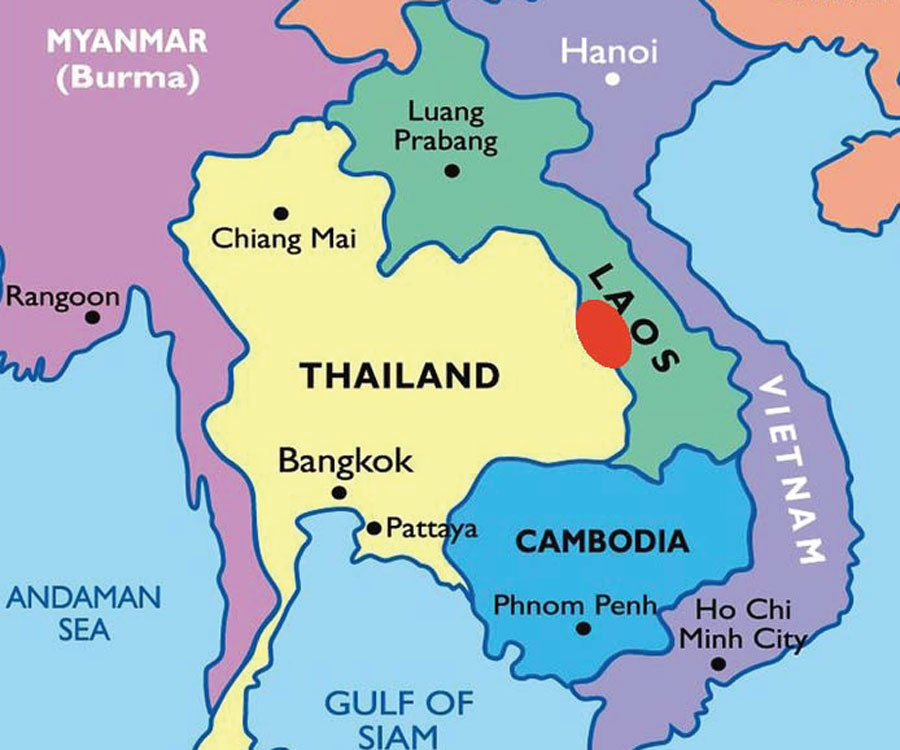






Join the Conversation
Interested in starting, or contributing to a conversation about an article or issue of the RECORDER? Join our CSEG LinkedIn Group.
Share This Article